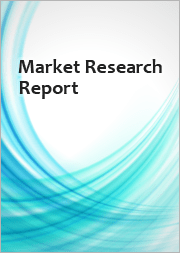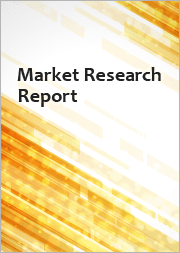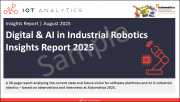
|
시장보고서
상품코드
1783022
세계의 디지털 및 AI 분야 산업용 로봇 인사이트(2025년)Digital & AI in Industrial Robotics Insights Report 2025 |
||||||
샘플 미리보기



소프트웨어 플랫폼과 AI의 진보가 자동화 능력을 재정의하는 동안 산업용 로봇의 상황은 큰 기술적 변화를 겪고 있습니다. 제조업, 자동화, 기술 개발 지도자들에게 이러한 추세를 정확하고 최신 형태로 파악하는 것은 전략적 계획과 경쟁력을 유지하는 데 필수적입니다.
이 보고서는 산업용 IoT 및 AI에 대한 지속적인 조사의 일환으로 로봇 분야의 디지털 플랫폼과 AI의 최신 동향을 분석한 것입니다. 본 보고서는 2025년 독일 뮌헨에서 개최된 Automatica에서 실시한 50건 이상의 인터뷰 및 일부 2차 조사를 기반으로 합니다.
샘플 미리보기



보고서 개요
- 58페이지의 PDF 보고서 : 최신 로봇 트렌드를 분석한 자세한 문서입니다.
- 10가지 주요 동향 분석 : 로봇에서 디지털 플랫폼 및 AI에 대한 가장 중요한 진전을 검토합니다.
- 3개 회사의 OEM 상세 비교 : 주요 공급업체가 IoT 플랫폼, AI 구성 및 모바일 로봇 제품을 상세하게 비교합니다.
- 50 명 이상의 전문가 인터뷰에서 통찰력 : Automatica 2025에서 로봇 OEM, 스타트업 및 통합 업체에서 얻은 직접적인 관점을 소개합니다.
- 5가지 유형의 로봇 분류 내역 : 거치형, 협동형, 모바일형, 서비스 로봇, 휴머노이드 로봇의 역할과 시장 상황을 개관합니다.
샘플 미리보기

언급된 기업
이 보고서에 언급된 기업의 일부 :
|
|
목차
제1장 서론
제2장 산업용 로봇의 디지털 플랫폼
제3장 산업용 로봇의 AI
- 개요
- 거치형 및 협동형 로봇의 AI
- 이동 로봇의 AI
- 서비스 및 휴머노이드 로봇의 AI
4장 IoT Analytics 정보
JHS 25.08.13A 58-page report analyzing the current state and future vision for software platforms and AI in industrial robotics - based on observations and 50+ expert interviews.
Sample preview
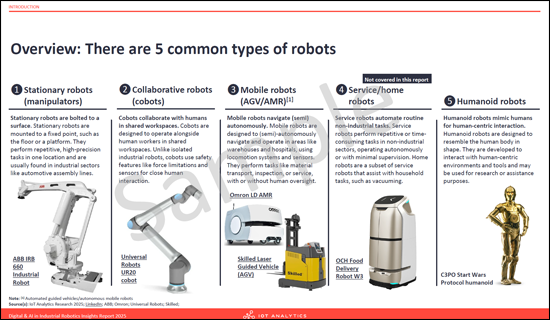
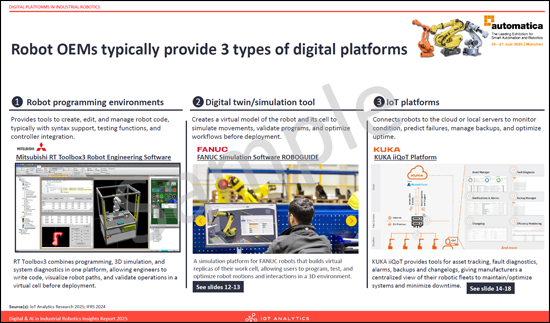
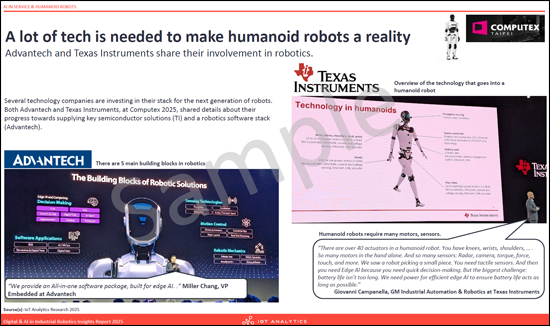
Introduction
The industrial robotics landscape is undergoing a significant technological shift as advancements in software platforms and artificial intelligence redefine automation capabilities. For leaders in manufacturing, automation, and technology development, a current and objective understanding of these trends is critical for strategic planning and maintaining a competitive edge.
As part of our ongoing coverage of industrial IoT and AI, this report presents a timely analysis of the state of digital platforms and AI in robotics. The insights are based on observations and over 50 interviews conducted at Automatica 2025 in Munich, Germany, supplemented by selected secondary research.
The result is a 58-page report compiled to help readers stay apprised of the newest trends in industrial robotics and the evolving market landscape. The report examines the software strategies of leading OEMs and provides a deep dive into the key use cases and technologies driving the next generation of industrial automation.
Sample preview
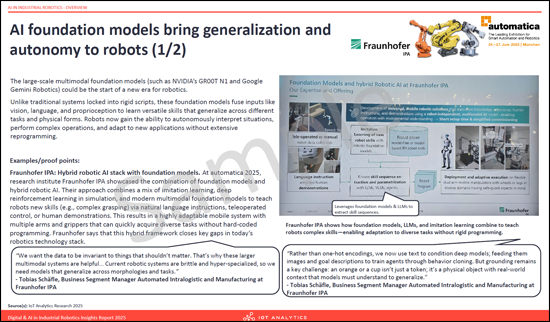
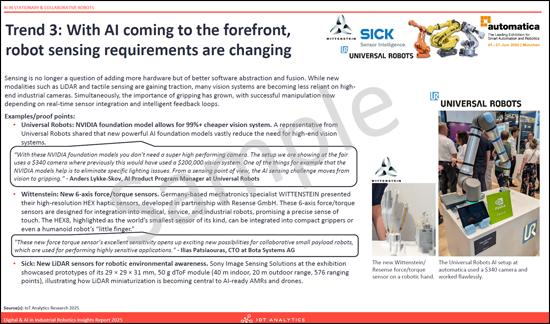
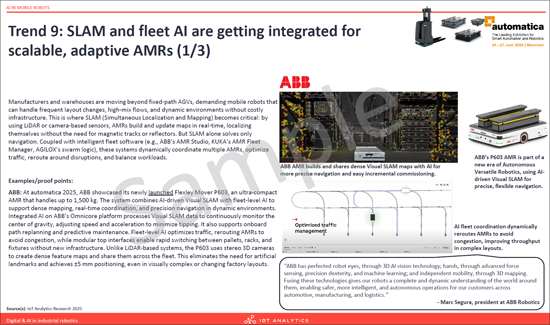
Report at a glance
- 58-page PDF report: A detailed document analyzing the latest robotics trends.
- Analysis of 10 key trends: A review of the most important developments in digital platforms and AI for robotics.
- 3 in-depth OEM comparisons: Detailed examinations of the IoT platforms, AI setups, and mobile robot offerings from leading vendors.
- Insights from 50+ expert interviews: Direct perspectives from robotics OEMs, startups, and integrators at Automatica 2025.
- Breakdown of 5 robot types: An overview of the roles and market status for stationary, collaborative, mobile, service, and humanoid robots.
Sample preview
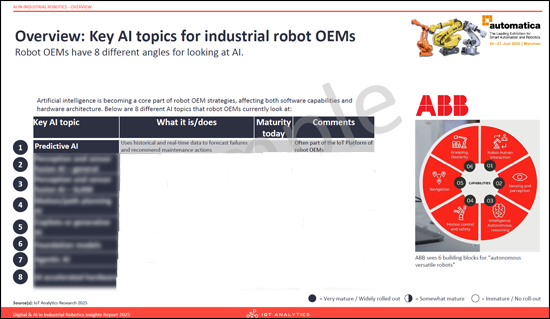
Key areas of analysis:
The report's analysis includes an in-depth look at several key areas:
- OEM digital platform strategies: An examination of the three types of software platforms offered by robot OEMs: programming environments, digital twin/simulation tools, and IoT platforms. The analysis includes a detailed comparison of the IoT platform offerings of leading vendors.
- The role of AI in robotics: A deep dive into the key AI topics for industrial robot OEMs, including perception, motion planning, and the emerging role of foundation models. The report includes detailed comparisons of the AI setups of leading stationary and mobile robot manufacturers.
- Emerging technology trends: An analysis of 10 key trends observed at Automatica 2025.
- Market overview and context: An analysis of the global industrial robotics market, including annual installation data by country, industry, and vendor.
A data-driven foundation for key business functions
This research is designed to provide a data-driven foundation for key business functions:
- For corporate strategy & product management: The report's analysis of OEM platform strategies and emerging technology trends provides the necessary intelligence to benchmark product roadmaps and identify new market opportunities.
- For CTOs & engineering leadership: The deep dives into AI hardware and software architectures, including the role of AI compute and changing sensor requirements, offer a clear view of the technological trajectory of the industrial robotics market.
- For market intelligence & competitive analysis: The detailed comparisons of vendor offerings in IoT platforms and AI serve as a central, objective source of intelligence for assessing the competitive landscape.
- For automation & manufacturing leaders: The analysis of key use cases and trends provides a practical guide to the latest advancements in robotic automation, from virtual commissioning with digital twins to the adoption of AI-driven quality control.
Key concepts in industrial robotics
Types of robots
The report provides context on the five common types of robots in the market:
- Stationary robots: Robots mounted to a fixed point, typically used for repetitive, high-precision tasks in industrial settings.
- Collaborative robots (cobots): Robots designed to operate safely alongside human workers in shared workspaces.
- Mobile robots (AGV/AMR): Robots that navigate (semi)-autonomously to perform tasks like material transport and inspection.
- Service robots: Robots that automate routine, non-industrial tasks in sectors like healthcare and logistics.
- Humanoid robots: Robots designed to resemble the human body for interaction in human-centric environments.
OEM software platforms
The analysis covers the three core types of digital platforms that robot OEMs typically provide:
- Robot programming environments: Tools to create, edit, and manage robot code.
- Digital twin/simulation tools: Software to create virtual models of robots and their work cells for offline programming and validation.
- IoT platforms: Software to connect robots to the cloud or local servers for condition monitoring, predictive maintenance, and fleet management.
Questions answered:
- What types of robots currently exist, and what are their roles?
- What types of software platforms do robotics OEMs provide?
- How many robots have been installed, and which industries and regions lead in these installations?
- What are key focus areas of AI in robotics and how do they differ among robotic OEMs?
- What are robotics executives saying about the current and future states of robotics?
- What are key use cases for AI in robotics?
- How do IoT platforms of different robotics OEM compare?
Companies mentioned:
A selection of companies mentioned in the report.
|
|
Table of Contents
1. Introduction
2. Digital platforms in industrial robotics
3. AI in industrial robotics
- Overview
- AI in stationary & collaborative robots
- AI in mobile robots
- AI in service & humanoid robots






